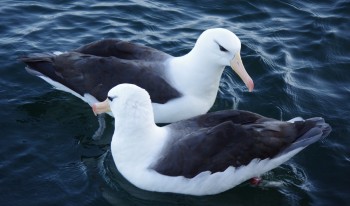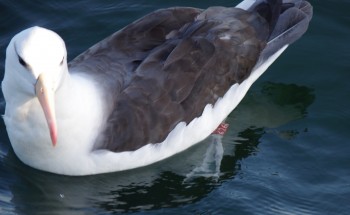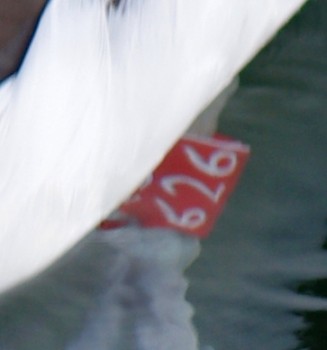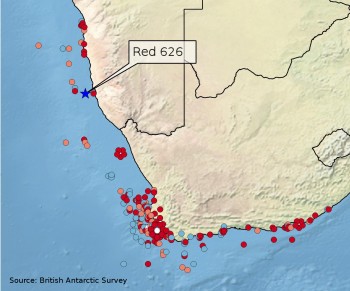On 7 May 2014 Kolette Grobler of the Namibian Ministry of Fisheries and Marine Resources observed a Black-browed Albatross Thalassarche melanophris on the sea surface next to her research vessel the !Anichab (= “place of many birds”) about 30 nautical miles west of Lüderitz in southern Namibia at 26° 38’S while on a routine environmental sampling cruise. The bird was banded with a metal band on the right leg and a red plastic band with the number 626 engraved in white on its left.




Red 626 showing its plastic and metal bands though the clear and calm water
Photographs by Kolette Grobler
An enquiry to the British Antarctic Survey (BAS) reveals that the bird was banded at Bird Island, South Georgia (Islas Georgias del Sur)*. Andy Wood of BAS reports to ACAP:
“We do in fact have a Red 626 in the Black-brow database carrying metal ring number 1425876. It is unsexed, and was ringed as an adult - we use the convention of unknown aged birds having metal rings on the right leg, so that fits with the observation. Red 626 has been a breeding bird at Bird Island since it was ringed in 2007/08, returning every season to breed with the same partner Red 141. They have successfully raised chicks in 2007/08, 2008/09, 2010/11 and 2012/13. The breeding history of Red 626 will undoubtedly extend earlier than 2007/08, but it uses a study colony newly started at that time. Red 626 and Red 141 bred again this season at Bird Island, but their nest failed in mid-January. From our tracking studies, many Black-brows finishing breeding at Bird Island head off to southern African coastal waters, and we have past ringing recoveries from Namibia. Great to hear more about one of the Bird Island birds.”

Southern African recoveries and sightings of Black-browed Albatrosses from Bird Island from the 1960s. Blue circles represent sightings, brown longline casualties and red deaths from other causes. Locations over land are due to inaccurate reporting. Map by Andy Wood, British Antarctic Survey.
It is noteworthy that whereas this bird and its mate have attempted breeding together for at least eight years in a row they have only been successful in fledging a chick every second year.
With thanks to Kolette Grobler, Jessica Kemper and Andy Wood for information and photographs.
John Cooper, ACAP Information Officer, 14 May 2014
*A dispute exists between the Governments of Argentina and the United Kingdom of Great Britain and Northern Ireland concerning sovereignty over the Falkland Islands (Islas Malvinas), South Georgia and the South Sandwich Islands (Islas Georgias del Sur y Islas Sandwich del Sur) and the surrounding maritime areas.

 English
English  Français
Français  Español
Español